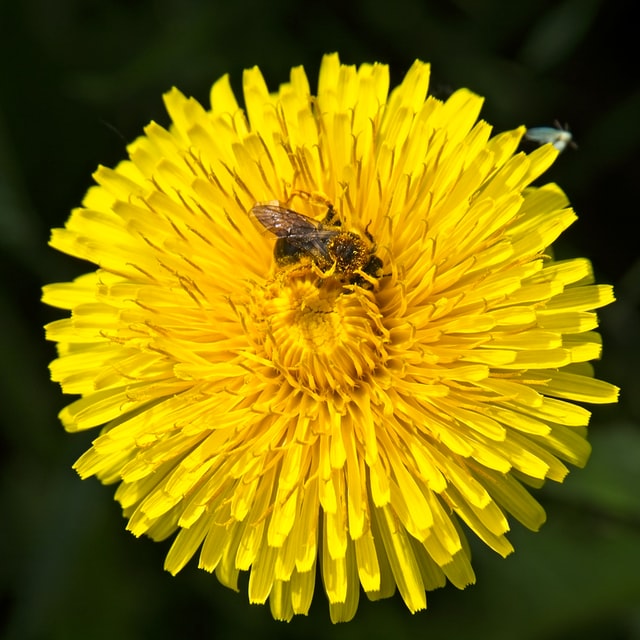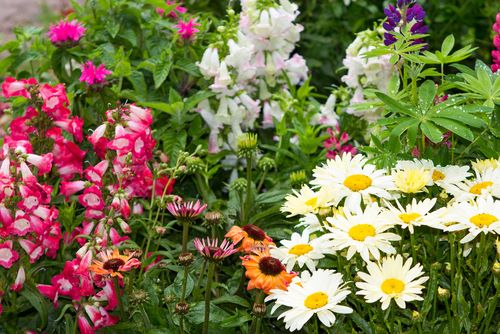Log in or create new account to save this product to your wishlist.
How to Encourage Bees in Your Garden
A world without bees would be bleak — indeed, without these furry pollinators, the human race would likely starve! So would the wild animals that rely on plants to survive. Therefore, it’s in everyone’s interest that this delicate life force remains strong and abundant. And this is why our gardens are more than just places […]
Latest blogposts
7 MIN 22 Jul How to keep your lawn in shape this summer 9 MIN 15 Jul Watering Your Garden: 10 Top Tips! 11 MIN 15 Jul Is Your Grass Type Right for your Garden? 4 MIN 03 Sep Gardening in September — jobs to do 5 MIN 14 Aug Pruning Lavender: when, why and how? 5 MIN 09 Aug 4 Tips for more Ergonomic Gardening!A world without bees would be bleak — indeed, without these furry pollinators, the human race would likely starve! So would the wild animals that rely on plants to survive. Therefore, it’s in everyone’s interest that this delicate life force remains strong and abundant.
And this is why our gardens are more than just places to relax and kick back with a glass of wine at the end of the day. Our gardens are areas rich in plant life — choose the right plants, and you encourage bees onto your veg patch or flowerbeds.
This blog is all about encouraging bees into your garden — discovering the plants and conditions most likely to tempt these essential pollinators.
Ready? Let’s get buzzing.
Why tempt bees into your garden?

Bees collect nectar and pollen from your garden plants for food for themselves and to feed their larvae. This helps sustain their population — but by moving from one flower to another, the bee pollinates each plant, which helps sustain the plant’s reproduction.
For flowers in flowerbeds, this means abundant flowering and seed production for the following year’s crop. For fruiting plants, such as tomatoes, cucumbers, pumpkins, courgettes, peppers, chilis, and aubergines, pollination is essential in converting the flower into a fruit.
So, bees promote plant growth, living symbiotically with plant life — without plants, there would be no bees; without bees, there would be fewer edible and decorative plants.
Are bees the only pollinators?
We often consider insects troublesome, but our lives rely entirely on pollinating insects, such as flies, wasps, beetles, moths, and butterflies. And don’t forget that flies play an essential role in the decomposition process, ensuring the world isn’t overflowing with rotting organic material.
Indeed, we should pay heed to the insect world — and the most critical role we can play is to provide them with an environment that sustains them.
How to encourage bees and pollinators into your garden
Gardens are excellent habitats for pollinators, and providing a plethora of pollen- and nectar-rich plants ensures that insects will visit.
However, we can also create suitable environments for nesting, which is another way to support their lives.
Making Your Garden a Haven for Bees

Choosing Bee-Friendly Plants
Select plants that will provide a rich source of nectar and pollen (see list below). Bees are attracted to many flowering plants, but they particularly like blue, white, yellow, purple, and violet blooms.
When selecting plants, try to choose a combination of differing shapes and sizes to cater to different bee species. Some bees have long tongues and can feed on flowers with deep corolla tubes, while others have short tongues and prefer open flowers.
Planting for All Seasons
To provide a year-round food source for bees, choosing plants that will flower at different times of the year is essential. This way, you’ll provide a constant source of nectar and pollen for bees, helping support species that fly at different times of the season.
In spring, consider planting crocuses, hyacinths, and wild lilacs. Summer-blooming plants that bees love include bee balm, cosmos, echinacea, snapdragons, foxglove, and hostas. For autumn, zinnias, sedum, asters, witch hazel, and goldenrod are all excellent choices.
Nurturing Native Plants
Native plants are the natural choice for a bee-friendly garden. They’re generally well-adapted to your local soil and climate conditions, and native bees have evolved alongside these plants, meaning they’re well-suited to pollinating them.
In addition to wildflowers, many native shrubs and trees, such as willow, apple, pear, and blackthorn, offer valuable nectar and pollen sources for bees.
Which plants attract pollinators?

There are hundreds of garden plants that attract pollinators. I’ll list them by season:
Winter pollinating garden plants
- Clematis cirrhosa
- Helleborus (including hybrids)
- Crocus
- Tree ivy
- Musk willow
- Sweet box (sarcococca confusa)
- Viburnum tinus
Springtime pollinating garden plants
- Field maple
- Sycamore
- Horse chestnut
- Bergenia (including Elephant Ear)
- California lilac
- Cornelian cherry
- Spring-flowering crocus
- Euphorbia (range of varieties)
- Geranium
- Hebe
- Helleborus
- Lily of the Valley
- Prunus laurocerasus (cherry laurel)
- Prunus x yedoensis (flowering cherry)
- Lungwort
- Spring fruiting bushes, such as blueberry, pear, peach, apricot
Summer pollinating garden plants
- Yarrow
- Hollyhock
- Peruvian lily
- Angelica
- Snapdragon
- Crested poppy
- Borage
- Butterfly bush (buddleja/lilac)
- Marigold
- Honeysuckle
- Cornflower
- Honeywort
- Foxglove
- Heather
- California poppy
- Sunflower
- Jasmine
- Bay
- Lavender
- Flowering tobacco
- Fennel
- Sage
Autumn pollinating garden plants
- Anemone
- Campanula poscharkskyana
- Clematis
- Crocus
- Dahlia
- Ivy
- Michaelmas daisy
- Fatsia japonica
- Salvia
- Arbutus unedo
- Chrysanthemum
Cultivating Your Bee Garden

Planting in Clusters
When planting your garden, try to group the same plants together.
Bees are more attracted to clusters of flowers rather than individual plants scattered throughout the garden. This is because bees typically only visit one type of flower per foraging trip, so a cluster of the same flowers allows them to forage more efficiently.
Letting Your Garden Grow Wild
Consider letting parts of your garden grow wild to provide a bee habitat. Many species of wild bees nest in dead wood, while others prefer to burrow in sandy soil.
By leaving a patch of your garden to grow naturally, you’ll provide these bees with the necessary habitats.
Adding a Bee Hotel
Adding a bee hotel to your garden offers a safe space for bees to nest and lay their eggs.
You can easily make your own bee hotel by filling a wooden box with hollow stems or drilling holes into a wood block.
The Role of Water and Shelter in Attracting Bees

Providing a Water Source
Like all living creatures, bees need water to survive.
You can provide a water source for bees by installing a shallow dish or birdbath in your garden. However, add a few pebbles or stones to give the bees a place to land so they don’t drown.
Providing Shelter
In addition to food and water, bees also need shelter.
Some bees will nest in hollow stems or holes in wood, while others prefer to burrow in the ground.
Leave a patch of your garden undisturbed or add a pile of logs — these can provide valuable nesting sites for bees.
Avoid Pesticides
Pesticides can harm bees, so it’s best to avoid using them in your garden.
Instead, focus on creating a healthy, balanced ecosystem that includes natural pest predators.
If you must use pesticides, choose the least harmful ones to bees and apply them in the evening when bees are less active. Never apply pesticides directly into open flowers, which will most likely damage pollinators.
The Joy of Weeds
While many gardeners view weeds as a nuisance, they can actually be beneficial for bees.
Many common weeds, such as dandelions and clover, provide valuable nectar and pollen sources for bees. So, consider leaving a few for the bees next time you’re pulling weeds.
Embracing your Lawn
Did you know that your lawn can be a valuable habitat for bees?
Many lawn grasses produce flowers that are a good pollen source for bees, and clover and dandelions are two of the most bee-friendly plants around. By letting your lawn grow a little longer, you can help support bees.
Provide a Bee-Friendly Habitat
There are many ways to provide habitats for bees in your garden.
This could involve:
- Leaving a patch of garden to the wild
- Adding a bee hotel
- Installing a beehive
By creating a welcoming environment for bees, you can help support their populations and contribute to their conservation.
Any questions
I hope I’ve provided all the answers you might need to encourage bees into your garden. But if you have questions, don’t hesitate to get in touch.
Or check out our Help & Advice section for expert guides to caring for your lawn and garden.
Thanks for reading!
Leave a comment
Your answer will be displayed on the site and the interested party will be notified by email.
Leave a comment
Have a question or want to share your experience? Leave us a comment.
Read more
The best tips and tricks for a lush green lawn
 7 MIN
13 Sep
Lavender Cuttings: a step-by-step guide
7 MIN
13 Sep
Lavender Cuttings: a step-by-step guide
 11 MIN
10 Sep
Create Your Low-Maintenance Garden – Tips and Ideas
11 MIN
10 Sep
Create Your Low-Maintenance Garden – Tips and Ideas
 Scarifying Kit
All products after scarifying | Quickly restores the lawn after scarifying | Outsmart weeds quickly with the use of this kit
From: € 39.99
Scarifying Kit
All products after scarifying | Quickly restores the lawn after scarifying | Outsmart weeds quickly with the use of this kit
From: € 39.99
 Spring Lawn Care Kit
MOOWY’s choice for the spring | Quick recovery of your lawn after winter | A strong lawn prevents weeds
From: € 25.99
Spring Lawn Care Kit
MOOWY’s choice for the spring | Quick recovery of your lawn after winter | A strong lawn prevents weeds
From: € 25.99
 Long Lasting Lawn Fertiliser
Effective for 90 days | See results in 14 days! | Suitable for all types of grass and soil
From: € 13.99
Long Lasting Lawn Fertiliser
Effective for 90 days | See results in 14 days! | Suitable for all types of grass and soil
From: € 13.99
Do you want a lawn calendar?
🌱 All important maintenance moments for your lawn during the year. Leave your email and we will send you the lawn calendar for free.
Enter your email
Receive the lawn calendar in the mail
Enjoy a green lawn all year round!










Comments (0)
There are no comments yet. Well then, what are you waiting for to
Be the first to write your comment!inaugurate this pretty page?
Do you have some comments?